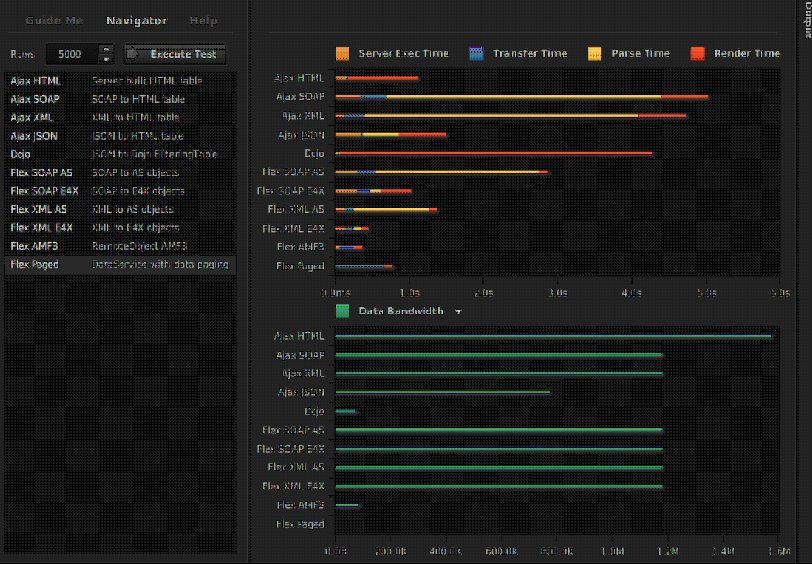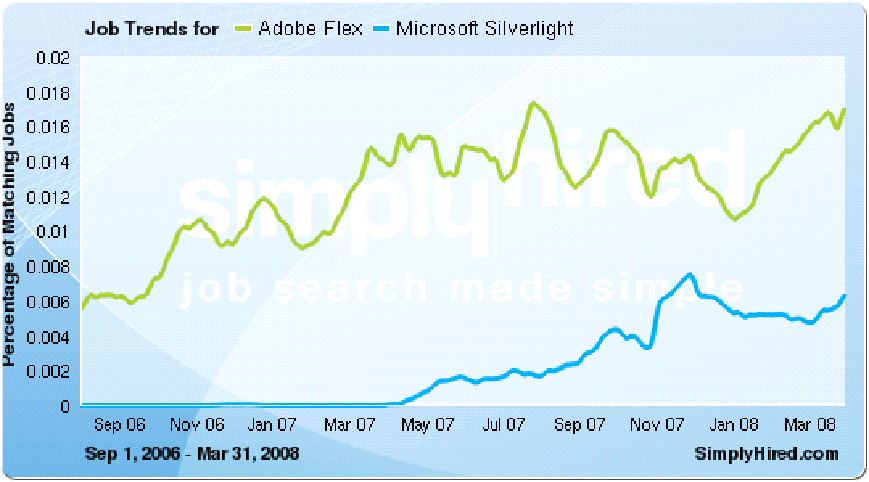The problem :-
The Internet was originally designed for simply transporting documents and information. The technology it was built upon lacked the interactivity of desktop applications. That's changed in the past decade as innovators have developed a richer user experience, despite huge challenges.
The Solution :-
With RIAs we can now deliver very sophisticated, responsive, interactive and graphically rich applications over the web.RIA technologies are not only enriching user experiences, but also empowering businesses to reduce development time and costs, taking web development to a whole new level. The second wave of web applications is now starting to roll in. The questions companies need to ask internally is when to get on board, and how best to ride the tide.
FIVE DRIVING FORCES OF RIA
1. Broadband
Most RIA applications require download of an initial “thin client” application. This was a huge barrier when the majority of Internet users relied on dial-up connections. Broadband gets rid of this barrier and enables heavier content transports such as audio and video streaming.
2. Computing Power Shift
The difference in computing power between PCs and servers has narrowed significantly. For example, desktops, laptops and PDAs now offer audio, video, and color. RIAs utilize more client computing power than traditional send and receive web applications. This shift has created an ideal environment for RIA
3. Better Response to User Actions
Today more than ever, businesses demand complex and responsive applications.
Ex : Simple graphic banners or spot ads are gradually being replaced by interactive and programmed ads called “Rich Media.” Some Rich Media ads can even keep track of more than 20 different user interactions.
4. Leading Tech Companies Make Their Move
Big companies have begun to realize the benefits of RIA. For example, Google Maps and Gmail leverage RIA by using a technique called “AJAX” (Asynchronous JavaScript and XML).
5. Web Services & SOA
Web Services and SOA enable presentation layers to be completely independent from business logic layers. Most RIA platforms are pluggable presentation layers on top of existing middleware, thanks to the power of Web Services and SOA.
List of RIA Platforms / Approaches (Wikipedia)
- Adobe Flash, Flex and Adobe AIR
- Backbase
- Curl
- Google's GWT framework (Google Web Toolkit)
- Java applets
- Java applications
- JavaFX
- JavaScript / Ajax
- Microsoft ActiveX controls
- Microsoft Silverlight
- Mozilla Prism
- OpenLaszlo
- REBOL 2.6 and Seaside for Smalltalk
Adobe Flex is a framework that allows a developer to build user interfaces by compiling MXML, an XML based interface description language. This Adobe Flex framework is compiled and turned into a compressed SWF file to be run in the Adobe Flash player.
Ajax
Ajax (asynchronous JavaScript and XML), or AJAX, is a group of interrelated web development techniques used for creating interactive web applications or rich Internet applications. With Ajax, web applications can retrieve data from the server asynchronously in the background without interfering with the display and behavior of the existing page. Data is retrieved using the XMLHttpRequest object or through the use of Remote Scripting in browsers that do not support it. Despite the name, the use of JavaScript, XML, or its asynchronous use is not required.
Silverlight
Microsoft Silverlight is a framework that allows a developer to build user interfaces by compiling XAML, an XML based interface description language. This Microsoft Silverlight framework is compiled and turned into a compressed XAP file to be run in the Silverlight plug-in
Flex Vs Ajax
Forrester analyst Jeffrey Hammond, with other Forrester writers including Carey Schwaber, Ron Rogowski and Jacqueline Stone, authored a best practices article titled “AJAX or Flex, How to Select RIA Technologies” which addresses the advantages and selection criteria when considering the use of Flex or AJAX for RIA development. Here are some pertinent excerptsPerformance Flex Vs Ajax
from that piece:
AJAX is an incremental path to a better user experience. However, just because a development team has chosen to go with AJAX doesn’t mean that its tool selection effort is complete. There remains the important decision of how many and what type of AJAX frameworks to use.”
“Flex delivers productivity in the long run but takes more time to learn. Adobe is an attractive RIA solution because it combines powerful development tools (Flex) with a near-universal browser plug-in (Flash) that’s designed to simplify RIA deployment.”
“Managers who have concerns about small commercial AJAX providers or support issues with open source AJAX frameworks consider Flex a safe alternative. But there is a downside: To be productive in Flex, developers have to learn two new languages and an extensive runtime framework — something that can take between one and three months to learn.“
The study concludes with the following decision drivers:
“Use AJAX for tactical improvements and Adobe Flex for strategic implementations.
Choose AJAX when time-to-market is critical and updates are frequent. Experienced Web developers ramp up on AJAX quickly. AJAX also makes it easy to build RIA capabilities into existing apps with small, frequent releases. Finally, AJAX’s customization capabilities make it possible to tune client frameworks to meet specific application footprints; this makes AJAX the better solution for smaller RIA deployments and for deployments where performance is critical.
Use Flex for large-scale user productivity apps. Although Flash’s client footprint is larger than AJAX frameworks, its market penetration makes it the preferred deployment platform for larger, comprehensive RIAs. Adobe is a safe choice for those who place a high value on reliable support and product continuity, concerns that are key when making strategic technology investments. The downside is that safely comes at the price of openness.“

Flex Vs Silverlight – Possible Outcomes
There are four possible outcomes that I see. The first is that Flex will continue to dominate the market place due to the maturity of their existing products, the widespread use and acceptance of Flash, and the large investments made by major software vendors in Flex technology. Microsoft will steal some market share but in the end it will be another failed attempt to conquer the web. I feel that this is the most likely scenario. Microsoft is already losing market share in the browser war and the operating system war, although they still have a tremendous lead over their competitors. Google is becoming a dominant force on the web and open source technologies are dominating the Web 2.0 world. In every aspect of computing, Microsoft is dealing with stronger competition then they have ever seen before. RIA will be even more challenging because they are not the leader in this space.
The second most likely option that I see is that Silverlight matches Flex’s market share. The big advantage that Microsoft has is the development environment and the fact that Flex currently does not integrate with .Net backends (although they are working on it). Microsoft already has a huge developer community and many of these people can easily be persuaded to adopt Silverlight as their RIA of choice. For companies that produce consumer facing content or control the end user client machines, the Silverlight plug-in issue is not that big of a deal. Many consumers are willing to download Silverlight plug-in just as well as they will download Flash, QuickTime, and others. It is the companies that deliver applications to other enterprises that will have the challenge. As a chief architect for a medium size company, one of our criteria for selecting vendor tools is that the tool is zero-footprint or requires no installation of software on client PCs. Many other IT shops will have the same constraint because of the B2B nature of their applications. If you have no control over the client’s desktop, forcing clients to push software out on their network can be a huge show stopper.
A third possible outcome is Silverlight will fail to gain any significant market share. I find this highly unlikely. Microsoft has a ton of money and smart people behind this product. Their product vision appears to be very solid on the surface and their initial product offering is impressive for the short amount of time that they have been in the RIA space. They should easily capitalize on the numerous loyal Microsoft shops that are already in place today and I expect them to strike several more big partnerships similar to the MLB deal. I think that over the next 2-3 years Silverlight will capture about 20-30% of the market share but no more.
A fourth possible outcome is that more competition will flood the market and other products will also compete heavily for market share. JavaFx and open source project Open Laszlo are already competing, but I believe this will be a two horse race between Flex and Silverlight.
Source www.irrlicht3d.org
| Technology | Platforms | GFX Rendering | Availability |
| Flex/AIR | Win/Mac/Linux | Excellent | very good |
| .NET/Silverlight | Win, ~Mac | OK | poor |

source : www.simplyhired.com
http://www.simplyhired.com/a/jobtrends/trend/q-adobe+flex%2Cmicrosoft+silverlight




3 comments:
thanks for the good article , I found another such article would like to share :
http://askmeflash.com/article/11/flex-vs-javascript-html-ajax-a-comparison
Nice Post. thanks for sharing all this topics about Silverlight.
Your article is awsome with easy understanding. Before reading your article AJAX was unclear to me now i can easily describe it :D
Post a Comment